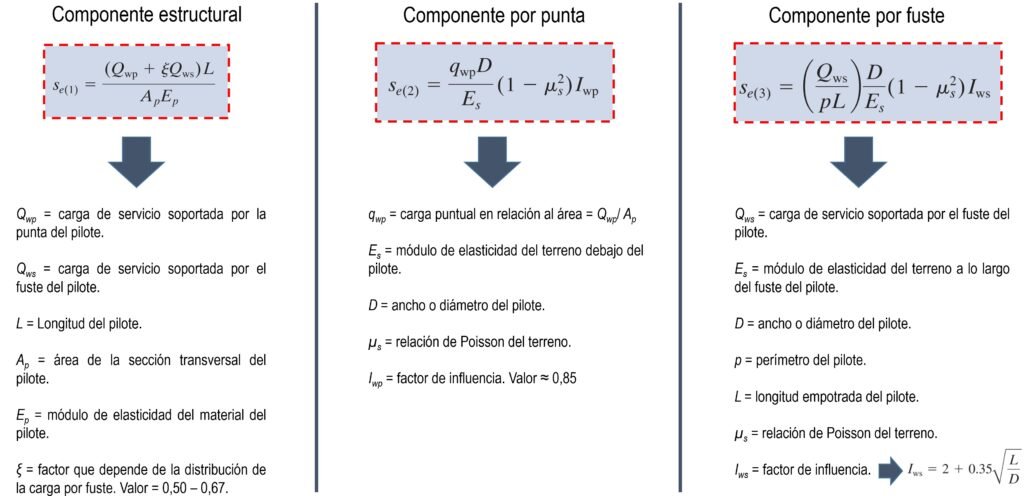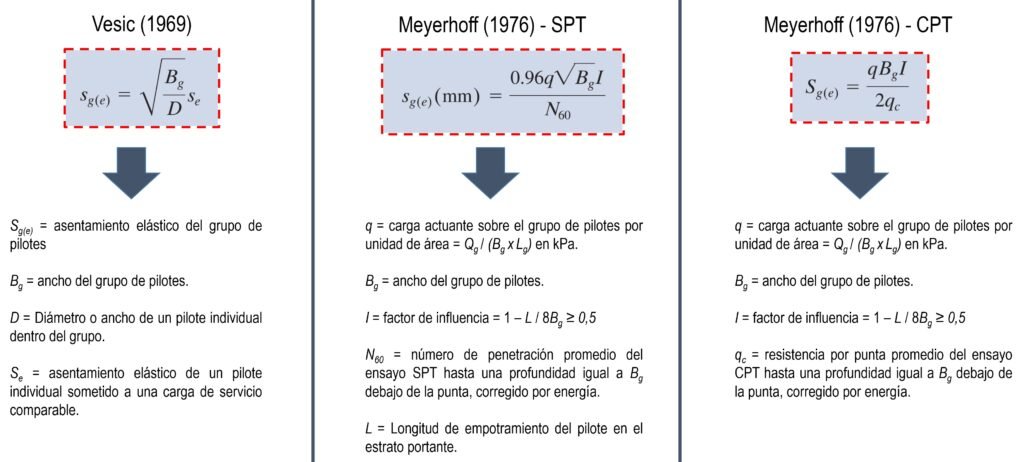

How to estimate the settlement of single piles and pile groups?
Like any foundation, piles experience settlements when subjected to loads from the superstructure. However, the estimation of the magnitude of such settlements, even though there are different methodologies for this purpose, constitutes one of the major sources of uncertainty in any geotechnical project involving the use of pile foundations. Do you want to know more about how to estimate the settlement of single piles and pile groups? Continue reading...
Content
Components of a single pile settlement
As pointed out by Prof. Das (2012), the settlement of a single pile is associated with three components, which are illustrated in Figure 1:
- 1. The settlement that we call "elastic", which considers the deformation of the structural element as such, assuming an approach based on the Theory of Elasticity (i.e., this term refers to the deformation of the pile itself, based on the response of the materials that compose it to external loads).
- 2. The settlement associated with the component of strenght corresponding to the pile tip.
- 3. The settlement associated with the component of the strength corresponding to the pile shaft.

Figure 1 Settlement components for a single pile (Source: modified from Atkinson, 2007).
According to the above, it is possible to state that the settlement of a single pile will depend on the stiffness associated to:
- - The material with which the pile is constructed.
- The soil below the zone of influence of the pile tip.
- The soil around the pile shaft.
It is evident from the components that affect the settlement of the single pile, the need to properly estimate the stiffness parameters of both the pile material itself and the soil in which it will be installed.
Settlement of single piles
Over the years, numerous methods have been developed to estimate the settlement of individual piles, most of them based on theoretical approaches adjusted by means of influence factors. One of these methods is the one proposed by Vesic in 1969, published by the Transportation Research Board, in USA. Figure 1 summarizes the expressions proposed by that researcher to estimate the three settlement components outlined in the previous section.

Figure 2 Expresions for settlement estimations for single piles (Source: modified from Vesic, 1969, CB Das, 2012).
As can be seen from the figure above, the settlement associated with the structural component of the pile is related to the acting service loads (not to increased loads) and, of course, to the pile material, reflected in the modulus of elasticity Ep, and to the pile dimensions, reflected in the factors L and Ap. Based on a very simple analysis of this expression, it is clear that the stiffer the pile (i.e. the larger its modulus of elasticity Ep), and the larger its cross-section (i.e. the larger the area at the tip Ap), the smaller the settlement associated with the structural element.
In relation to the settlement associated with the tip, it depends on the modulus of elasticity of the soil below the tip, in the zone of influence of the pile, up to a depth of 2 to 3 diameters below the pile tip.
The settlement component associated with the shaft has a similar expression to that used for the tip, except that in this case it is considered the load absorbed by the shaft, again the modulus of elasticity of the soil, and an influence factor estimated with the expression shown in the figure come into play.
An important thing to note here is how to estimate the QWP and QWS loads, which are the portions of the service load absorbed by the tip and shaft, respectively. Logically, the only way to determine these parameters accurately is by performing a load test.
However, Das (2012) mentions that QWS/pL can be assumed as the average value of the estimated shaft unit strength for the pile. This assumption is based on the fact that, as we have reviewed in a previous post (see https://geo-webonline.com/en/interaccion-pilote-terreno-de-fundacion/), relatively small movement is required for the pile to develop its capacity per shaft.
Accordingly, assuming that the capacity per shaft is fully developed, the load associated with the settlement at the tip QWP is determined by simply subtracting the service load minus Qws.
Another important aspect to take into account is the proper estimation of the modulus of elasticity of the soil, which is one of the most difficult parameters to determine in Soil Mechanics. I invite you to review two posts previously published in geo related to the best way to estimate the modulus E from the shear modulus G: https://geo-webonline.com/que-significa-que-el-suelo-tiene-un-comportamiento-no-lineal/ and https://geo-webonline.com/uso-del-modulo-de-corte-g-en-analisis-de-asentamientos-de-cimentaciones-bajo-cargas-estaticas/.
Although these expressions are not the most accurate of methods, they are relatively easy to apply, and serve to give an order of magnitude of the expected deformation in a pile subjected to a service load.
Settlement of a group of piles
In relation to the settlement of a pile group, as reviewed by Das (2012), some research developed between the 1960s and 1970s showed that the settlement of a pile group, when the service load absorbed by each individual pile is similar (i.e. when there is an approximately equal distribution of the service load among each of the piles that make up the group), increases with the group width Bg and with the center-to-center spacing of the piles d.
Figure 3 summarizes three relatively simple expressions for the estimation of the settlement of a pile group, which can be used in routine projects.

Figure 2 Expresions for settlement estimations for single piles (Source: modified from Vesic, 1969, CB Das, 2012).
The first of the expressions is the one proposed by Vesic in 1969, which is basically based on the settlement of a single pile subjected to an equivalent load to the one it has within the group, affected by a factor depending on the geometrical characteristics of the group.
The other two expressions, proposed by Meyerhoff for groups of piles in sands and gravels, are based on information available from SPT and CPT field tests, which are the two most commonly employed tests around the world in routine geotechnical studies.
As in the case of single piles, these expressions serve to provide a preliminary estimate and an order of magnitude of the expected deformations for the pile group when subjected to service loading. For projects where more precise estimates are required, more complex models, such as those based on finite element models, should be applied.
References
- Atkinson, J. (2007) “The Mechanics of Soils and Foundations”. Second Edition. CRC Press – Taylor & Francis Group. Abingdon, UK.
- Coduto, D. (2001) “Foundation Design: Principles and Practice”. Second Edition. Prentice Hall. New Jersey, USA.
- Das, B. (2012) “Fundamentos de Ingeniería de Cimentaciones”. Séptima Edición. CENGAGE Learning Editores, S.A. México D.F, México.